5.7 Problems
Section 5.1
Different kinds of media.
What is the restoring force for each of these media, and does it support longitudinal waves, transverse waves, or both? Air, Water, Slinky, Trampoline, Drum, Foam rubber.
Section 5.2
Interference - same frequency, same direction.
Imagine that you are standing in front of two speakers as shown below.
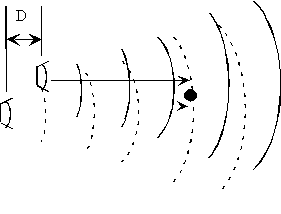
a) If the wavelength of the sound is l = 10 cm and the second speaker is moved back by a distance of 20 cm, do we have constructive or destructive interference?
b) How much further back must we move the second speaker to reverse the situation in a)?
c) If we play a tone with a frequency of 550 Hz, what separation between the speakers will produce destructive interference? (There are many answers, just give one.)
Interference.
a) We start with two speaker emitting pure tones at 1500 Hz. Your distance from each speaker is R1 and R2, respectively:

When the speakers are very close to each other, do we have constructive or destructive interference?
b) We now move speaker 2 backwards a distance D:

How far must we go to switch from constructive to destructive or destructive to constructive interference?
c) Now we move speaker 2 to the side by a distance D:
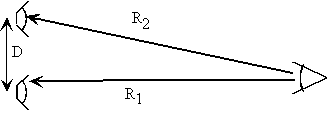
Again, how far must we go to switch from constructive to destructive or destructive to constructive interference, if R1 = 2 meters? Calculate this exactly. (Hint: you know R1. Figure out what R2 should be to give the correct interference condition. Then use the Pythagorean Theorem to get D.)
Interference.
Consider the following arrangement of speakers, which are facing each other. We measure the sound waves between the speakers:

a) If we use a frequency of 3500 Hz, what is the wavelength of the sound wave?
b) If we are exactly half way between the speakers, what is R2 - R1? Will we have constructive or destructive interference?
c) How much must we move to the left to be in the opposite situation as in part b)? (Both R1 and R2 are going to change.)
d) How does the answer to c) relate to what you know about the distance between nodes and antinodes on a standing wave?
Section 5.3
Pitch of sound from steps.

Suppose you are in a Greek theater surround by steps with a depth D = 3 feet. If you clap your hands loudly, you will get an echo from the steps. However, the echo from the lowest step will arrive first, then the echo from the next step and so on. All of the echoes will sound like a pitch. What pitch will this be?
Interference from steps
a) Assume that you are standing in front of some steps and that when you sing a note with a frequency of 450 Hz the echo sounds loud due to constructive interference. What is the length of each step?
b) What other frequencies will also sound loud due to constructive interference?
c) What kind of series do these frequencies form?
Destructive interference.
a) Assume that while singing in front of some steps you hear no echo at a frequency of 500 Hz because of destructive interference. What is the length of each step?
b) What frequencies would you hear loudly?
Interference from steps.
a) Assume that you are standing in front of some steps with a width of 2 meters. What frequencies will sound loud due to constructive interference?
b) What kind of series do these frequencies form?
c) What frequencies are not be heard due to destructive interference?
d) What series do these frequencies form?
Steps.

You are singing in front of some steps with a width D = 0.746 m.
a) If you produce a frequency of 230 Hz, will that show constructive or destructive interference when it reflects off of the steps?
b) Now you sing at 345 Hz. Will this frequency show constructive or destructive interference?
Hollow walls
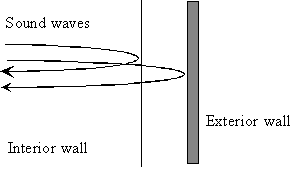
a) A wall consists of a strong exterior wall and a light interior wall with a gap in between for insulation. Assume that the interior wall is very thin. If the gap between the interior and exterior wall is 10 cm, what frequency of sound will be strongly reflected by the whole structure?
b) What frequency of sound will exhibit destructive interference and get absorbed by the wall?
Interference from a wall.
You are playing a low "A" at 110 Hz in front of a (solid) wall that is 0.78 meters away from you.
a) Will the reflected sound constructively or destructively interfere with the direct sound you are producing?
b) Will the second harmonic constructively or destructively interfere?
Interference in a concert hall.

You are sitting in the audience listening to a tuba play a low E = 137.5 Hz. Some of the sound comes to you directly, while some reflects off of the wall behind the orchestra.
a) Will the direct sound and reflected sound interfere constructively or destructively where you are sitting?
b) If the tuba plays a note a Perfect Fifth higher, will there be constructive or destructive interference?
Section 5.4
Interference of ultrasound.
a) Ultrasound has frequencies around 40,000 Hz. What wavelength does this correspond to?
b) If you stand three meters way from two speakers separated by 20 cm, how much would you move your head to go from dead spot to the next?
 Interference Pattern.
Interference Pattern.
Two speakers project sound waves with a wavelength of 5 cm in all directions and are placed 5 cm apart. If you walk in a circle around the speakers, mark the points with an X where the sound would be the loudest. Then mark with a · where the sound would be the softest.
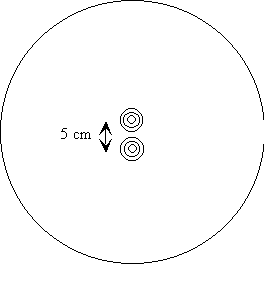 Interference patterns.
Interference patterns.
a) Consider sound waves with a frequency of 3430 Hz. What is the wavelength of this sound wave?
b) In each case below, two speakers are placed a certain distance apart, as labeled. Mark on the circle approximately the locations were you would find constructive interference (X) and destructive interference (· ).
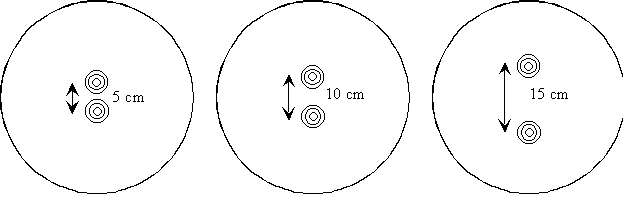 8) Interference Patterns.
8) Interference Patterns.
The following diagrams show where you would hear constructive (X) and destructive (·) interference of the waves from the two sources (O) of sound.
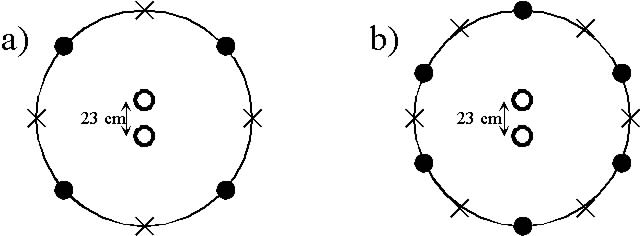
a) In diagram a), what is the wavelength and frequency of the wave?
b) In diagram b), what is the wavelength and frequency of the wave?
Section 5.5
Intervals.
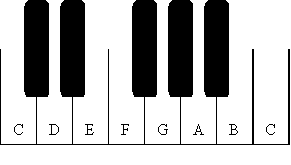
a) The note 'C' on a piano has a frequency of 264 Hz. If we go up by an interval of a fifth and down by an interval of a Just third, you have a new interval called a minor third. What is this ratio? What frequency is a minor third above 'C'?
b) Pythagoras would create a minor third by going up a fifth and coming down by a Pythagorean third. What is this ratio? What is the frequency of the note?
c) What is the beat frequency between the notes found in parts a) and b)?
Beats between overtones.
a) Take a note with a fundamental frequency of 420 Hz. What note is an interval of a fourth higher?
b) What are the frequencies of the overtones that these notes have in common? (Assume that the overtone series of each note is a complete harmonic series.)
c) If the second note is out of tune by being 3 Hz too high, what is the beat frequency between the first common overtones?
Beats.
a) Consider a note with a frequency of 1000 Hz. What note is an interval of a fifth higher?
b) What is the beat frequency between these two notes?
c) This beat frequency is rather high and the ear will not think of it as a "beat". Rather, the ear will simply interpret it as a new pitch. What interval below the original note will the beat frequency be at?
Beats.
a) Two clarinetists play the same note with a frequency of 440 Hz at T = 10° C. What is the wavelength of the tone?
b) Now, one clarinet warms up to T = 12° C. If the wavelength stays the same, what is the pitch now?
c) What will be the frequency of the beats between the two clarinets?
Remember, the speed of sound = (331.3 + 0.6T) m/sec, where T is the temperature in ° C.
Section 5.6
Frequencies of Light Waves.
Light, which is a wave, travels through space with a speed of 3x108 m/sec. Find the frequency of the following: (1 nm = 10-9 m)
a) Radio waves with l = 120 m.
b) Red light with l = 730 nm.
c) Ultraviolet light with l = 300 nm.
d) Microwaves with l = 3 cm (used in police radar).
Hydrogen Spectrum
Hydrogen produces light with characteristic frequencies. The first four wavelengths are 121.5 nm, 102.6 nm, 97.26 nm, and 94.98 nm. (1 nm = 10-9 m).
a) Convert these wavelengths to frequency.
b) Write these frequencies as ratios with the fundamental (for example, a metal bar is 1.00f, 2.54f, 5.40f, etc.)
c) Show that the ratios for the overtones are given by (4/3)(n2 - 1)/n2. You need to find the integer n for each ratio.
d) Using the formula (4/3)(n2 - 1)/n2 find the interval that the first two overtones make with the fundamental.
e) For very large n, what interval does this ratio approach?
f) Predict the next wavelength in the above hydrogen series.
Miscellaneous.
a) A lightning bolt hits the ground 1 mile away from you. How long does it take the flash of light to reach you?
b) How long does it take the sound to reach you? What is a simple relationship to convert from seconds between the flash and the sound to figure out the distance?
c) Microwave ovens use a frequency of 2.45 GHz. If this radiation formed a standing wave in your microwave oven, what would be the distance between nodes and antinodes? How does this distance compare to the size of a potato? This is why there are rotating platters in such ovens.
Interference with light waves.
So far, we have only considered interference effects with sound waves. However, the results we derived can be applied to any wave, including light waves. The only difference is that the speed of the wave will now correspond to the speed of light, v = 3x108 meters/second. The relations fl = v and R2 - R1 = yL/D still apply. Making two sources of light to interfere is not quite as easy as setting up to speaker. However, we can use the following set-up:
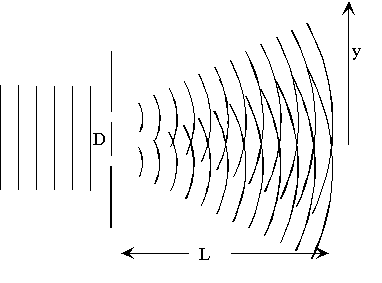
Two slits separated by a distance D create the two sources of light. If the wavelength of light is 600 nm (600x 10-9 m), the slit separation is 0.5 cm and the distance L to the screen is 1 m, what is the separation of the points of constructive interference.
Interference with light waves.
We want to use interference patterns to measure the wavelength of a beam of light with the following setup:

a) The two light waves that interfere are formed by two slits in a mask with a separation of 0.2 mm. (1 mm = 10-3 meters). If we measure the interference pattern 2.3 meters away from the mask and find that the spots of constructive interference are 4.5 mm apart, what is the wavelength of the light?
b) If the separation of the slits is made smaller by a factor of 1.5, what would be the separation of the spots of constructive interference?
Soap bubbles.
While making soap bubbles you notice that with the light behind you , the reflected light from the soap bubble looks green. How thick is the soap film? (Green light is around 530 nm).
Antireflection coatings for eyeglasses.
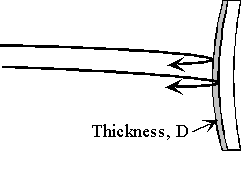
The eye can see over a range of wavelengths from about 400 nm to 700 nm. (1 nm = 10-9 m). We want to design the antireflection coating for the wavelength right in the middle of this range.
a) What is the middle wavelength, and how thick should the coating be to create destructive interference in the reflected waves at this wavelength?
b) For the thickness determined in part a), what wavelength will show constructive interference?
c) The antireflection coating is actually effective from about (4/3)l to (3/4)l , where l is the design wavelength in part a). Does this range cover the range that the eye can see?
Radio waves.
a) Your favorite radio station uses a frequency of 104.1 MHz. What wavelength does this correspond to?
b) If you are standing near a wall, your radio will pick up the direct signal from the station, as well as a reflection from the wall. How close to the wall would you have to be to find destructive interference?
Cavity modes of a laser.
Cavity modes of lasers are very similar to the acoustic cavities that we have been working with. However, there are some differences.
a) Consider a one dimensional cavity of light with a length of 50 cm. If the boundary conditions are the same as a closed-closed acoustic cavity, what is the frequency and wavelength of the fundamental mode?
b) This fundamental mode has a much lower frequency than the light generated by the cavity. If the light has a wavelength of 500 nm, what is the frequency of the light? What mode will this correspond to? (The mode number will be very large).
Gratings.
If we have a grating whose groove spacing is 10-6 meters at an angle of 25° , what wavelength of light will be reflected straight back along the horizontal direction?
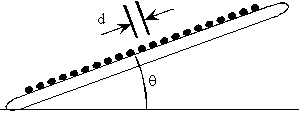 Gratings
Gratings
a) A grating has 300 steps/mm. What is the distance between steps, d?
b) You shine a laser with a wavelength of 630 nm at the grating. At what angle will the light reflect straight back at you?
c) At how many different angles will this happen?
 Grating.
Grating.

a) A grating has a line spacing of 0.6 microns = 0.6x10-6 meters. If is held at an angle of 30° , what is the longest wavelength of light will be reflected straight back?
b) What other wavelengths will be reflected straight back?
Steps/gratings.

Once again, we have a grating to reflect light. This time we want to know which angles of the grating will not reflect any light straight back.
a) In symbols, write down the path difference, R2 - R1, between two waves which reflect off of two adjacent grooves.
b) In symbols, write down the general condition for having destructive interference. Remember, you can always add multiples of the wavelength.
c) Now, set these expressions equal. If d = 6x10-7 meters, and l = 530x10-9 meters, what angles will give destructive interference? (There are only two such angles.)





















